Long before the modern world heard of Oxford or Harvard, there stood a university in the heart of India that drew scholars from across Asia. Its name was Nalanda — a place where wisdom flowed like the Ganges and where ideas were discussed freely under ancient banyan trees.
Located in present-day Bihar, Nalanda wasn’t just a centre of learning. It was a global powerhouse of education at a time when most of the world was still wrapped in intellectual darkness. At its peak, it attracted students from China, Korea, Tibet, Sri Lanka, and even Central Asia, all hungry for the kind of advanced knowledge India was offering.
While the West often takes pride in its Ivy League institutions, few know that Nalanda University thrived over 1,500 years ago, with a structure, spirit, and curriculum far ahead of its time.
This blog will take you through the rise, brilliance, mystery, fall, and revival of Nalanda — an ancient gem that still holds lessons for the modern world.
Table of Contents
Where and When Nalanda Began
Nalanda’s story begins in the 5th century CE, during the golden age of the Gupta Empire — a time when India was flourishing in art, science, philosophy, and literature. It was founded under the patronage of Emperor Kumaragupta I (circa 415–455 CE), who likely recognized the need for a formal institution that could preserve and expand India’s deep intellectual traditions.
The university was built in Rajgir district of present-day Bihar, near sacred Buddhist sites like Bodh Gaya and Rajgir Hills. This strategic location wasn’t a coincidence. It allowed Nalanda to become a bridge between spiritual seekers and scholarly minds.
The name “Nalanda” itself is believed to mean “giver of knowledge without interruption.” Some scholars trace the origin to a Nāga (serpent deity) who once lived there, while others link it to the word “Na-Alam-Da” in Sanskrit — meaning “no end to giving.”
By the 7th century, Nalanda had already become a living, breathing university town — complete with lecture halls, temples, dormitories, libraries, meditation spaces, and massive gardens. According to Xuanzang, the famous Chinese monk who studied there, the campus was “so vast that it took days just to walk through it.”
And this wasn’t just a religious centre. Though founded on Buddhist principles, Nalanda welcomed Hindu, Jain, and even early secular thought, encouraging open debate across belief systems. This tolerance and intellectual openness is what made it the first true residential university in the world.
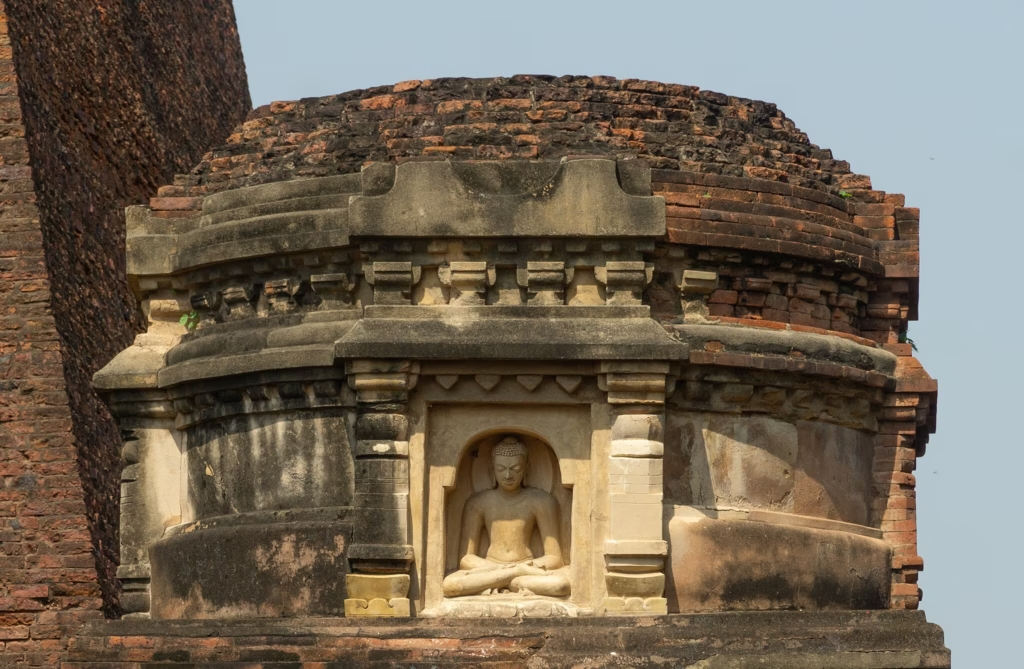
Sariputta Stupa – Nalanda Mahavihara
Image Credit: Sumitsurai, CC BY-SA 4.0, via Wikimedia Commons
https://commons.wikimedia.org/wiki/File:Temple_3_-Sariputta_Stupa–Stucco_Works–Nalanda_Mahavihara(19).jpg
The Campus That Stunned the World
Based on excavated ruins, the core Nalanda complex covered over 12 hectares — but historical records suggest the full university stretched across several hundred acres, making it one of the largest educational cities of the ancient world.
Imagine a campus so large with 8 separate compounds, 10 temples, classrooms, meditation halls, and gardens filled with lotus ponds. This was Nalanda in its prime — not just a university, but a self-contained city of learning.
The university had ten thousand students and over two thousand teachers, making it one of the largest educational institutions in the ancient world. Students didn’t just drop in for a course or two — they lived, studied, debated, meditated, and grew here for years. Admission was tough. Aspirants had to pass rigorous oral interviews at the gates, where scholar-monks tested their reasoning and depth of knowledge.
What set Nalanda apart wasn’t just size — it was structure. The buildings were crafted from red bricks, laid in geometric harmony. Multi-storey hostels housed students, complete with staircases, water wells, and even early sanitation systems. The layout was thoughtfully designed to create quiet spaces for learning and discussion.
But the crown jewel was its library complex, known as Dharmaganja. This wasn’t a single room of scrolls — it was a complex of three grand buildings:
- Ratnasagara (Ocean of Jewels),
- Ratnodadhi (Sea of Jewels), and
- Ratnaranjaka (Delighter of Jewels).
Legend says some structures were nine storeys tall, filled with manuscripts on every known subject — from astronomy to anatomy, from Buddhist metaphysics to Indian medicine.
Visiting Chinese scholar Xuanzang stayed at Nalanda for over a decade. In his detailed writings, he noted how deeply impressed he was by the discipline, infrastructure, and intellectual vibrancy of the place. He wasn’t the only one — another Chinese pilgrim, Yijing, also praised the order and quality of education he found at Nalanda.
At a time when Europe was still in the Dark Ages, Nalanda had lecture halls, libraries, dorms, and a functioning academic ecosystem — all centuries ahead of its time.
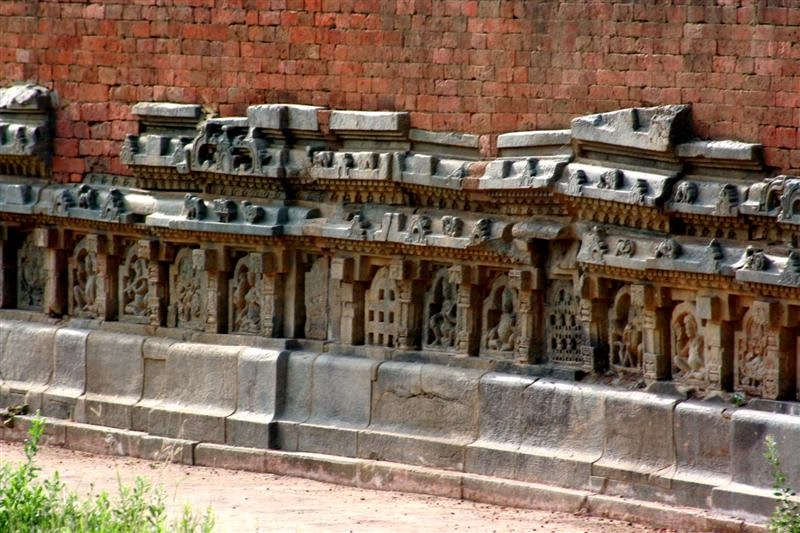
Image Credit: Chandan Singh from India, CC BY 2.0, via Wikimedia Commons
https://commons.wikimedia.org/wiki/File:Nalanda_(6)_(2322120854).jpg
What They Studied at Nalanda — A Curriculum Centuries Ahead
Nalanda wasn’t just about monks chanting scriptures. It was a multidisciplinary powerhouse where the brightest minds explored subjects that would make even modern universities take notice.
The core foundation was Buddhist philosophy — particularly Mahayana Buddhism — but the learning didn’t stop there. Nalanda’s curriculum stretched across religious and secular knowledge, integrating diverse fields under one roof:
- Logic and Debate (Nyaya and Tarka Shastra)
- Grammar (Vyakarana) – mastering Sanskrit and Pali to read ancient texts
- Medicine (Ayurveda and Buddhist healing systems)
- Mathematics and Astronomy – calculations, timekeeping, planetary systems
- Philosophy (both Buddhist and Brahmanical)
- Metaphysics and Psychology (Abhidharma)
- Arts, Architecture, Alchemy, Linguistics – yes, even early chemistry and design!
Every subject was taught with a deep emphasis on reasoning and discussion, not just memorization. Students had to defend their ideas in front of peers and scholars — a practice that echoes modern-day viva exams or academic peer reviews.
Students were also trained in mindfulness, meditation, and ethical conduct. Education at Nalanda aimed to shape not just the intellect, but the character. This blend of inner growth and outer knowledge made Nalanda unique in the world.
Thanks to scholars from Tibet, China, and Southeast Asia, Nalanda constantly updated its syllabus. When monks like Xuanzang and Yijing came from China, they brought texts and techniques with them — and took Indian knowledge back when they left.
The result? A flowing exchange of ideas, making Nalanda a living hub of international knowledge transfer, centuries before global universities became a trend.
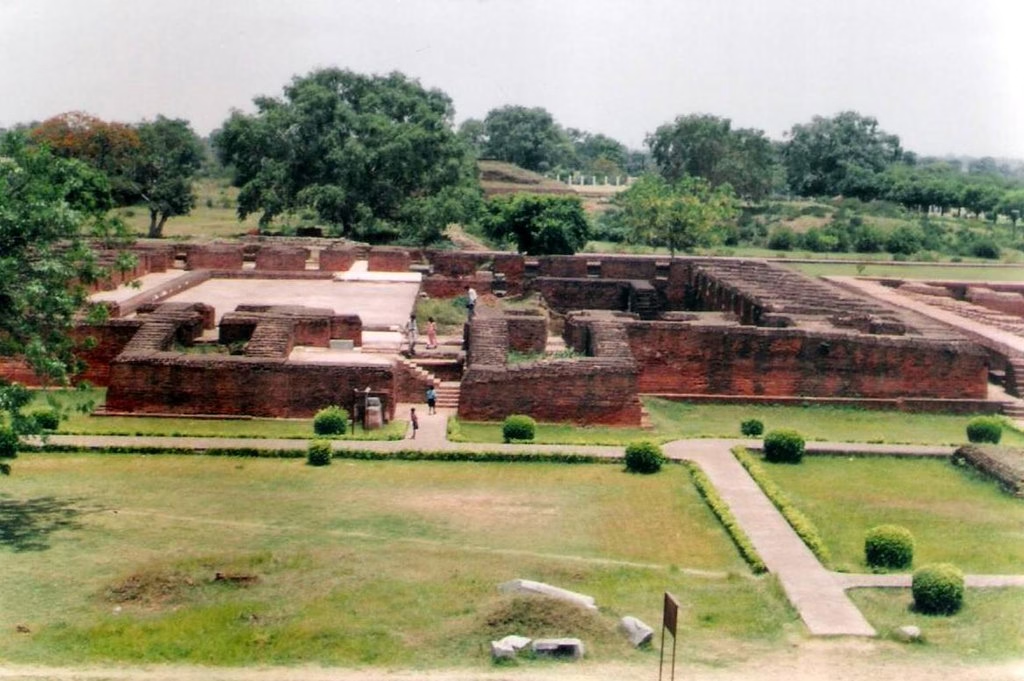
Image Credit: Vu2sga, CC BY-SA 3.0, via Wikimedia Commons
https://commons.wikimedia.org/wiki/File:Nalanda_3.JPG
An Ancient Global University Before the Word Even Existed
Before the modern idea of a “university” was even born, Nalanda had already become a magnet for international scholars. Long before globalization was a buzzword, students and teachers from across Asia and beyond traveled to this remote corner of India — not for trade, but for truth-seeking.
From the 6th to the 12th century CE, Nalanda welcomed students from:
- China – Most famously Xuanzang (Hsuan-Tsang) and Yijing, who spent over 10–15 years studying and documenting life at Nalanda.
- Korea and Japan – Buddhist pilgrims and translators arrived to learn and carry back texts.
- Tibet – Many core Tibetan Buddhist scriptures today are direct translations of works studied at Nalanda.
- Sri Lanka, Indonesia (Java), Mongolia, and possibly even Persian regions.
For these scholars, Nalanda wasn’t just a university — it was the academic capital of Asia.
Lectures at Nalanda were often held in Sanskrit, Pali, and sometimes Tibetan. Students lived in dormitories grouped by region or language, yet mingled freely in classes and debate halls. This multilingual atmosphere created an early prototype of global, intercultural education, based on dialogue, tolerance, and shared learning.
Nalanda became a translation hub too. Many Buddhist scriptures were translated into Chinese and Tibetan within its libraries and classrooms, helping shape religious and philosophical thought across Asia.
When Chinese monk Xuanzang returned home, he carried with him over 600 manuscripts and introduced advanced Indian logic and Buddhist thought to China. His writings are still some of the most detailed records we have of Nalanda’s glory.
Tibetan Buddhism, as we know it today, is deeply rooted in Nalanda’s teachings. In fact, many of the greatest Tibetan lamas identify themselves with the “Nalanda tradition.”
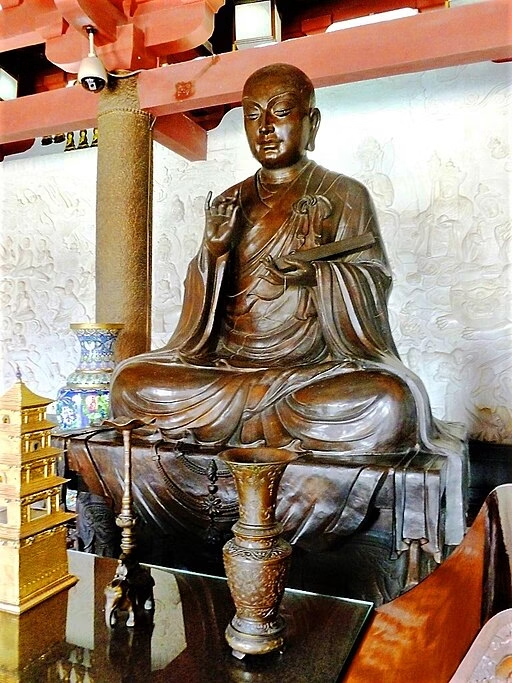
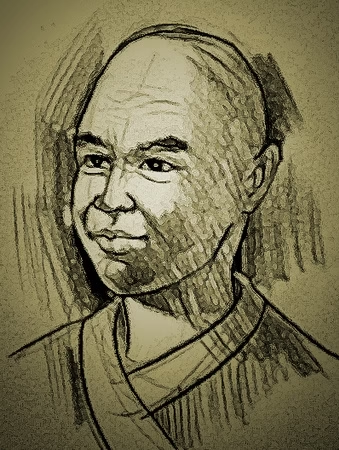
Xuanzang
Image Credit: John Hill, CC BY-SA 4.0, via Wikimedia Commons
https://commons.wikimedia.org/wiki/File:Nalanda_3.JPG
Yi Jing
Image Credit: User:L joo, Public domain, via Wikimedia Commons
https://commons.wikimedia.org/wiki/File:Yi_Jing.JPG
Bring Nalanda’s Peaceful Spirit Home
Nalanda was once a flourishing hub of Buddhist learning, where monks meditated in serene courtyards surrounded by art and wisdom.
Recommended:
Meditating Sitting Buddha Statue showpiece (Amazon)
Place it in your home or study space to invite calm, focus, and a touch of ancient heritage.
Disclosure: As an Amazon Associate, we earn from qualifying purchases. This helps us share more hidden stories of Bharat with you — at no extra cost.
The Mystique and Hidden Knowledge of Nalanda
Nalanda wasn’t just a place of learning — it was a place of legend. While scholars today speak of its curriculum and influence, ancient accounts hint at something deeper: lost knowledge, sacred manuscripts, and mysteries that were never fully understood.
One of the most enduring legends says that Nalanda’s library — the Dharmaganja — housed over nine million manuscripts. While that number may sound mythical, what’s certain is that the texts ranged from mathematics, medicine, and astronomy to magic, alchemy, and spiritual sciences. Some accounts even mention secret sections of the library, accessible only to master monks and teachers.
When Nalanda was attacked and burned in the 12th century (more on that in the next section), historical sources claim the library burned for months — some say six months, others say three. That detail alone hints at the colossal volume of palm-leaf manuscripts and scrolls that filled its towers.
What was in those texts? Some believe they contained:
- Advanced astronomical charts predating Copernicus,
- Surgical techniques and herbal formulations now lost to time,
- Tantric sciences and inner energy practices rarely written down elsewhere,
- And rare commentaries on now-extinct sutras and philosophies.
Locals in Nalanda still speak of underground tunnels once used by monks to escape during invasions or move sacred texts in secret. Some believe there are chambers beneath the ruins that have never been excavated, possibly holding remnants of the original scrolls, stone-carved inscriptions, or even Buddhist relics.
While mainstream archaeology hasn’t confirmed these theories, the layered brick architecture and unexcavated areas suggest that Nalanda’s story is far from complete.
It’s said that senior monks at Nalanda mastered an early form of mental visualization and memory training — similar to today’s “memory palace” technique. These monks could recite thousands of verses, diagrams, and arguments from memory — an oral tradition so refined that even without books, the knowledge would survive.
The Darkest Hour – The Destruction of Nalanda
Every great civilization has its moment of loss — and for India, Nalanda’s destruction was a wound that still echoes through history.
In 1193 CE, the famed university — which had flourished for over 700 years — was attacked by a Turkic general named Bakhtiyar Khilji, during the early invasions under the Delhi Sultanate. The reasons were many: religious intolerance, political dominance, and perhaps an inability to understand what Nalanda truly represented.
According to accounts, Khilji — reportedly suffering from illness — was advised by his Hindu physician to seek treatment from a monk at Nalanda. The monk cured him using Ayurvedic wisdom. But instead of gratitude, Khilji allegedly flew into a rage when he realized that the monks he had long considered “idle philosophers” possessed superior knowledge to his court.
Shortly after, his army descended upon Nalanda.
The attack wasn’t just military — it was cultural genocide. Monks were massacred, manuscripts were set on fire, and entire temples were razed. The great Dharmaganja Library, containing centuries of accumulated wisdom, burned for months. Eyewitnesses describe flames and black smoke spiraling into the sky for days.
Imagine losing the intellectual output of an entire civilization in a single act of destruction. India’s scientific, spiritual, medical, and philosophical texts — gone.
Historians estimate that thousands of manuscripts — many one-of-a-kind — were reduced to ash. And with them disappeared rare knowledge about the body, mind, stars, ethics, and enlightenment that had been carefully collected and preserved by generations of thinkers.
We may never fully know the depth of what was destroyed:
- Medical treatises that could’ve reshaped modern healing.
- Philosophical commentaries that predate Descartes or Kant.
- Early mathematical texts — possibly rivals of Pythagoras or Euclid.
- Esoteric Buddhist texts that were never written down again.
Only fragments remain today, thanks to monks like Xuanzang and Yijing who took copies to China and Tibet. But the heart of Nalanda was extinguished that day, and with it, India’s global leadership in education was set back by centuries.
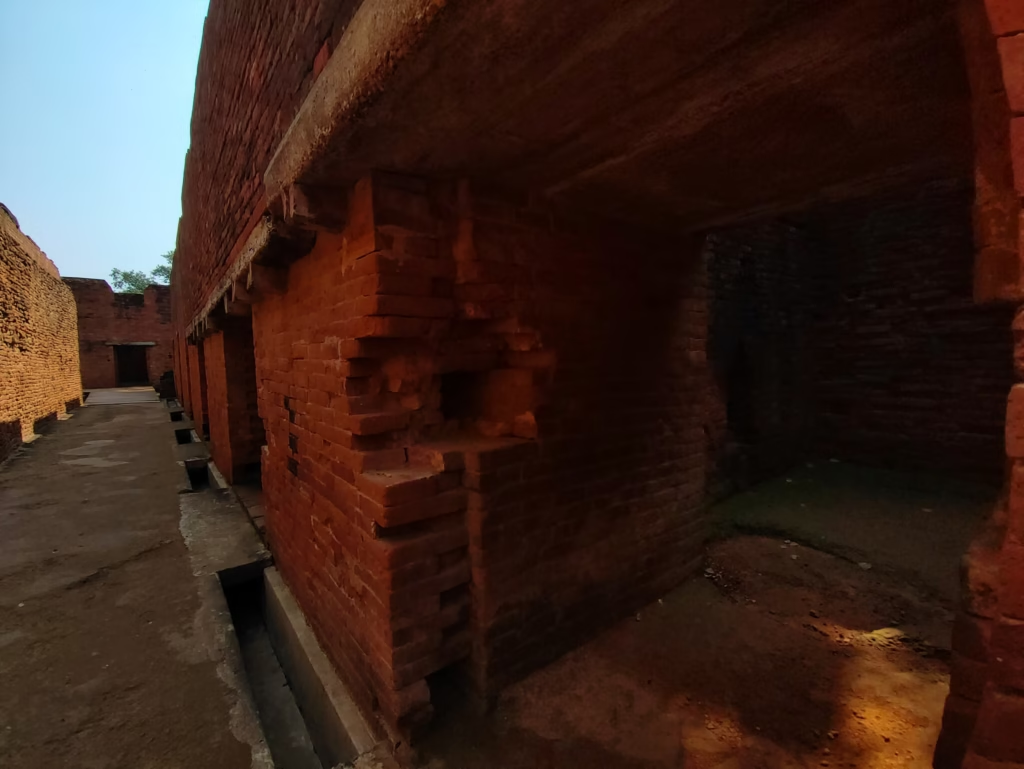
Nalanda Ruins
Image Credit: Vu2sga, CC BY-SA 3.0, via Wikimedia Commons
https://commons.wikimedia.org/wiki/File:Nalanda_3.JPG
Revival of Nalanda — From Ashes to a Global Symbol Again
For over 800 years, the ruins of Nalanda lay silent — red bricks buried under soil, memories fading into myth. But history wasn’t finished with Nalanda. In the 21st century, India decided to awaken this sleeping giant.
In 2010, the Government of India, along with support from 17 countries, began plans to revive Nalanda as an international university. The idea wasn’t to recreate the ancient structures, but to rebuild its legacy — as a modern hub for global wisdom and cross-cultural learning.
On September 1st, 2014, the new Nalanda University officially opened its doors near the original site in Rajgir, Bihar. This project was strongly backed by former President Dr. A.P.J. Abdul Kalam and PM Narendra Modi, who both saw Nalanda as more than an academic endeavor — it was a revival of India’s civilizational identity.
In June 2024, PM Modi inaugurated Nalanda University’s modern campus, just a few kilometers from the UNESCO-declared World Heritage ruins. The new campus is designed with sustainable architecture, Buddhist aesthetics, and international collaboration at its heart.
What Makes the New Nalanda Special?
- 17+ countries are founding partners, including Japan, China, Australia, and Singapore.
- Offers Master’s and PhD programs in Buddhist Studies, Ecology, Sustainable Development, Philosophy, and International Relations.
- Focuses on Asian civilizational dialogue, bridging ancient wisdom with modern challenges.
- Environmentally conscious: zero carbon footprint, solar-powered systems, and water harvesting structures.
The university has already attracted students and scholars from across the globe — just like its ancient ancestor.
Nalanda: Now a Global Heritage Site
In 2016, UNESCO recognized Nalanda Mahavihara (Ancient Nalanda University) as a World Heritage Site. This not only protects the ruins but also reestablishes India’s place on the world map of ancient civilizations.
Today, when you walk through the excavated brick walls of the original Nalanda, you’ll find remnants of lecture halls, meditation cells, shrines, and libraries — whispering stories of what once was. And just a few kilometers away, a new chapter is being written.
Why Nalanda Still Matters Today
In a world divided by borders, ideologies, and digital noise, Nalanda offers a timeless lesson: that true knowledge transcends geography, religion, and politics.
Over a thousand years ago, Nalanda created a model of education that many modern institutions are still striving to replicate — one that was global, inclusive, holistic, and deeply human. It brought together monks, scientists, healers, linguists, and philosophers under one roof. It valued debate over dogma, reason over repetition, and unity over uniformity.
Even today, the “Nalanda way of thinking” can help us:
- Combat extremism with dialogue and mutual respect.
- Bridge science and spirituality through integrated thinking.
- Prioritize education that shapes character, not just careers.
- Understand that ancient wisdom isn’t outdated — it’s a toolkit for our future.
You can still see Nalanda’s spirit in Tibetan monasteries, in Asian Buddhist universities, and in the Dalai Lama’s speeches, where he often speaks of reviving the Nalanda tradition of inquiry, compassion, and logic.
Even beyond Buddhism, Nalanda’s impact ripples into the foundations of global education. It reminds us that India wasn’t just the land of temples and kings — it was once the world’s classroom.
As we stand at a crossroads where education systems are being questioned and reimagined, Nalanda’s story isn’t just something to look back on — it’s something to build forward from.
Nalanda Wasn’t Just the Oxford of the East — It Was the Origin
To call Nalanda the “Oxford of the East” is actually an understatement.
Oxford was founded in the 12th century. Nalanda had already been thriving for over 600 years by then. It had hosted international scholars, maintained massive libraries, and developed a learning system far more advanced than anything the world had seen at the time.
Nalanda didn’t imitate. It inspired.
It showed the world that education could be rooted in ethics, driven by inquiry, and guided by the pursuit of truth — not power, not profit. Its revival today is more than a national project — it’s a reminder that India’s intellectual heritage is not lost, but waiting to be reawakened.
As we navigate a future filled with AI, automation, and anxiety, Nalanda’s legacy urges us to return to values that never age — compassion, clarity, critical thinking, and curiosity.
So next time someone tells you India was never a land of education, tell them about Nalanda — The university where the world once came to learn.
Frequently Asked Questions: About Nalanda University
1. Why was Nalanda University so famous?
Nalanda was the world’s first residential university, attracting over 10,000 students and 2,000 teachers from across Asia. It offered a wide range of subjects — from logic and medicine to philosophy and astronomy — and was known for its vast library and international reach.
2. Who destroyed Nalanda University and why?
Nalanda was destroyed around 1193 CE by Bakhtiyar Khilji, a Turkic general of the Delhi Sultanate. Historical accounts suggest it was due to religious intolerance and a lack of understanding of its intellectual significance.
3. How many years did Nalanda University operate before its destruction?
Nalanda flourished for over 700 years, from the 5th century CE until its destruction in the 12th century.
4. Is Nalanda University still active today?
Yes. The modern Nalanda University was revived in 2014 and is now an international institution located near the ancient ruins in Bihar, India. It was inaugurated by PM Narendra Modi and supported by 17 countries.
5. What was taught at Nalanda University in ancient times?
Subjects included Mahayana Buddhism, Vedic texts, logic, grammar, medicine, mathematics, astronomy, metaphysics, and more. It was a multidisciplinary institution far ahead of its time.
6. Can we visit Nalanda University ruins today?
Yes. The ruins of ancient Nalanda are open to visitors and are protected as a UNESCO World Heritage Site. A museum nearby displays relics, sculptures, and artifacts from the site.
7. What is the connection between Nalanda and the Dalai Lama?
The Dalai Lama often refers to himself as a “follower of the Nalanda tradition.” Many Tibetan Buddhist teachings and philosophies are rooted in what was once taught at Nalanda.
8. How big was Nalanda University?
The excavated ruins cover around 12 hectares, but historical texts suggest the full campus likely spanned several hundred acres, making it one of the largest learning centers of the ancient world.
9. What makes Nalanda different from modern universities?
Nalanda emphasized holistic education — developing intellect, ethics, and inner discipline. It promoted debate, diversity of thought, and was global in scope even 1,500 years ago.
10. What are the modern courses offered at the new Nalanda University?
The new Nalanda University offers postgraduate programs in Buddhist Studies, Philosophy, International Relations, Ecology and Environment Studies, among others.
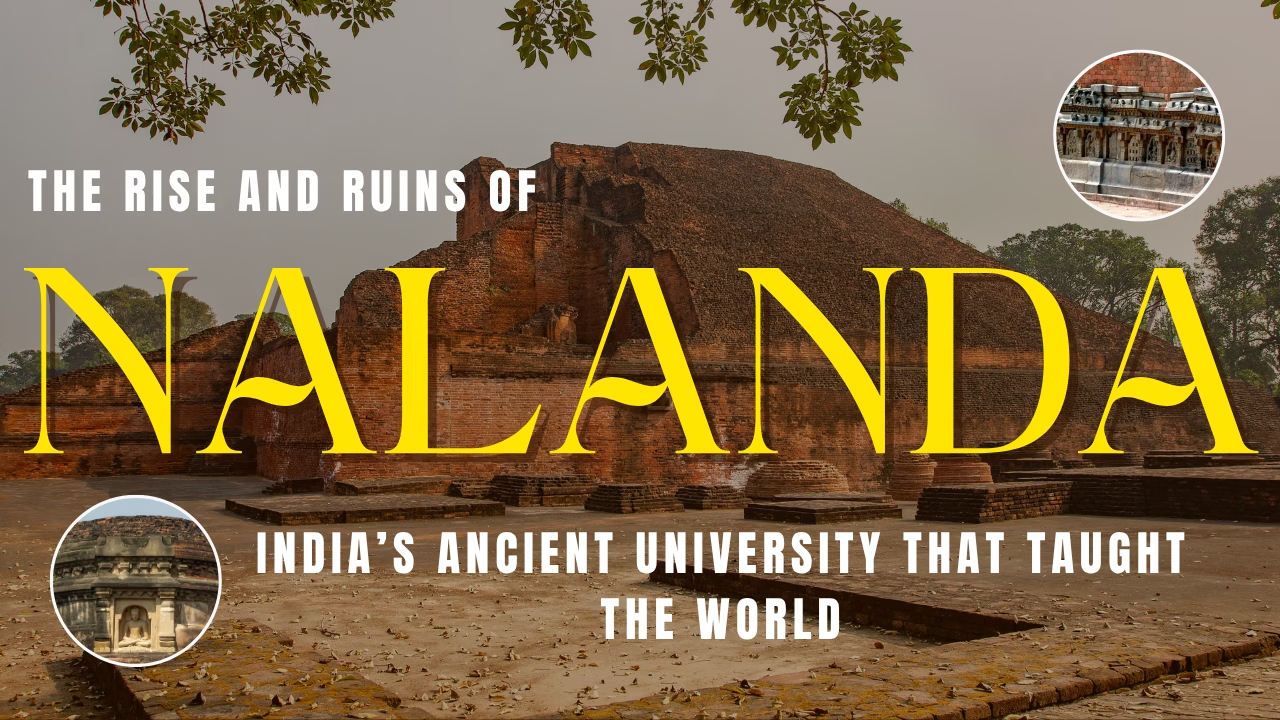



Love the content!!
So much to learn about our culture!!